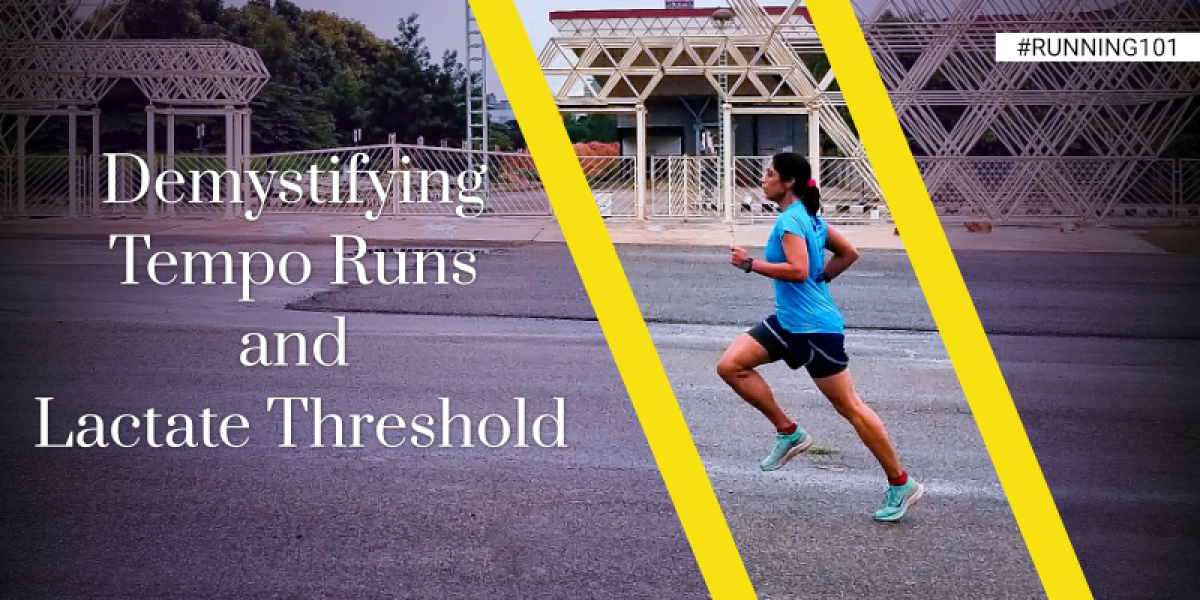
Tempos runs are faster than marathon pace and slower than interval pace. It is often expressed as 85% of maximum heart rate or 75% of maximum oxygen intake.
Another way of looking at tempo pace should be just within the aerobic range of activity, it should be a “comfortably hard” pace that you can sustain for around an hour in race conditions. (Lactic acid, or lactate, is a chemical by-product of anaerobic respiration — the process by which cells produce energy without oxygen around.)
The lactate threshold (LT) represents the highest intensity (or pace) we can manage before the body begins to exponentially accumulate lactate. Better the LT, it will help us to run in an aerobic state longer.
As runners, we tend to run initial miles of long runs very strong, because legs are fresh and a good recovery from the previous workout. However, our pace drops as the miles increase. This is where adding Tempo runs to our training comes handy.
The chart below shows the blood lactate levels of trained and untrained athletes at varying exercise intensities. As seen in the chart, trained athletes can run at a much higher intensity, before they reach their LT. Untrained athletes reach their LT at a much lower effort as a percentage of their VO2max.
By feel, Tempo runs should feel “comfortably hard”. One can know if they are running faster than their tempo pace when they start breathing too hard, and it’s time to slow down. Also when you train faster than the current lactate-threshold pace, you feel the “burn” of lactate accumulation in your muscles.
The most effective way to improve the Lactate Threshold is to run at the current lactate-threshold pace or a few seconds per kilometer faster. It is good to keep the distance at 800mts, 1km, 1mile to start with, and then progressively increase run duration. Below is a beginner Tempo workout.
If you are preparing for a half marathon with a weekly mileage of 40-45km, the distribution of runs w.r.t. Endurance, Tempo, and Intervals should be, Endurance runs - 50%-60%, Tempo runs - 20%-30% and Intervals 10%-20% in a training cycle. Here is an example distribution of mileage across different types of runs that I used in my training cycle as a run-up to the half-marathon race I was training for.
| # Week | Endurance Run | Tempo Run | Interval Runs | Weekly Mileage |
|---|---|---|---|---|
| Week 1 | 18km | 12km | 10km | 40km |
| Week 2 | 20km | 13km | 9km | 42km |
| Week 3 | 21 km | 14km | 10km | 45km |
| Week 4 | 22km | 12km | 11km | 45km |
The training pace for Tempo runs is typically between 10k and half-marathon race pace. If you have run a recent 10k time trial or a half-marathon, you can use those as a reference point for your tempo training pace.
Here is a sample pace chart for different levels of runners based on their finish time targets.
| Beginner | Intermediate | Advanced | Weekly Mileage | |
|---|---|---|---|---|
| Marathon Goal time | 4:30:00 | 3:45:00 | 3:00:00 | 40km |
| Marathon Pace | 6:24/km | 5:20/km | 4:16/km | 42km |
| Half Marathon Pace | 6:05/km | 5:04/km | 4:03/km | 45km |
| Tempo Pace | 5:46/km | 4:53/km | 3:58/km | 45km |
Measuring LT is best done using blood lactate test. Lactate levels in blood are measured at different times during a strenuous workout to find LT. GPS watches can help you find your approximate LT pace. Garmin GPS watch along with chest HR strap, you can perform LT test.
References:
Science of Running: Analyse your Technique, Prevent Injury, Revolutionize your Training; Napier, Chris

Aditi Pandya is an avid runner, a writer and a fitness enthusiast. She is second runners up at Airtel Hyderabad Marathon 2019, Vadodara International Marathon 2020 in Women half-marathon open & veteran categories respectively. She blogs at NarrativesByMe.com and can be reached on Insta narrativesbyme.
If you are a running enthusiast, follow us on our social media channels @geeksonfeet on Twitter, and GeeksOnFeet on Instagram and Facebook for updates.